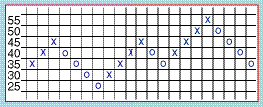Bridging The Gap
Linking Point & Figure And Bar Charts
by Robert Busby, Ph.D.
Point & figure is one of the oldest western techniques of charting, tracing its lineage back to Charles Henry Dow. Large numbers of financial professionals rely on point & figure (P&F) charts for buy and sell signals. An even larger group of professionals look at financial data in the form of time series, and prefer bar, line or candlestick charts. Devotees of these two "parallel universes" are frequently at odds with one another, each asserting that only their version of technical analysis is correct. Of course, many people use both techniques; but there is at least anecdotal evidence of a sizable body of technicians who do not cross boundaries.Ever thought of combining these two chart pattern techniques? Find out how.
P&F VS. TIME SERIES
P&F advocates say that their charts contain all essential market information, filtering out market noise and simplifying decision-making. They assert that only market movement counts, not the time required to make the moves. But those who prefer time series methods say that time affects the value of money, closing price affects margin calls (and therefore volatility), and open-to-close trends confirm close-to-close trends. No such information is available from P&F charts.
Even those who use both methods tend to use them separately, and do not combine them. Analysts might like to combine P&F charts mathematically and graphically with other indicators, but they don't generally have a method for doing so. They might want to test trading systems that combine traditional signals with P&F signals, but their software often will not allow it. For most market watchers, P&F charts are a technical end-game. Although many interesting patterns can be seen, further mathematical manipulation is not generally performed on them.
In addition, there are many methods for choosing box height and reversal numbers in P&F charting. Some systems use closing prices, while others use highs and lows. However, questions such as which choices give the most reliable signals or avoid the most false signals are normally decided by trial and error -- not explicit analysis.
In this article I will show that an alternative view of P&F can allow this important technique to be completely integrated with time series methods to their mutual advantage. I will discuss a new perspective on P&F and show how to combine P&F data with other analysis techniques. In addition, I will extend the P&F data to time-based data and show how to attack many of the difficulties that time series adherents raise. Nothing in this article suggests replacing P&F charts. I only suggest that other views of underlying data may shed additional light.
POINT & FIGURE DATA
Several popular methods are available for setting box values and box reversal numbers, but all methods produce a similar type of plot using Xs and Os or comparable symbols.
Let Price be the daily price series of some financial instrument; construct a P&F chart of Price using any chosen method. Figure 1 shows part of a P&F chart for Price. Now walk through the chart in sequence from the first X or O, and for each symbol encountered, record the box value. We call the resulting data sequence P&F data for Price, and denote it by PF(Price).

Figure 1: Part of a P&F chart for price
Next, replot the P&F chart, moving one square to the right before
entering each symbol as shown in Figure 2. Then replace the (now-unnecessary)
symbols with dots, and connect the dots. Figure 3 is a simple line chart
of the data PF(Price).

Figure 2: Same data, different drawing method. The data from the P&F chart is replotted by moving each of the symbols to the right at corresponding price levels.
...Continued in the January issue of Technical Analysis of STOCKS & COMMODITIES
Excerpted from an article originally published in the January 2005 issue of Technical Analysis of STOCKS & COMMODITIES magazine. All rights reserved. © Copyright 2004, Technical Analysis, Inc.
Return to January 2005 Contents